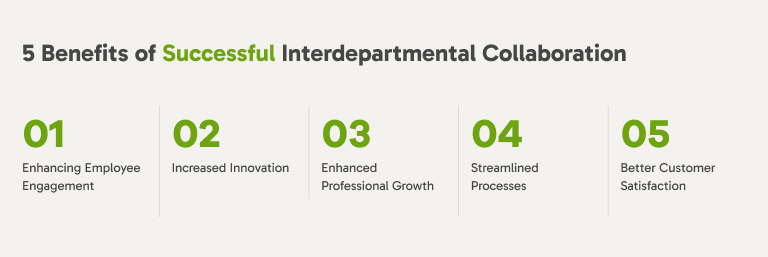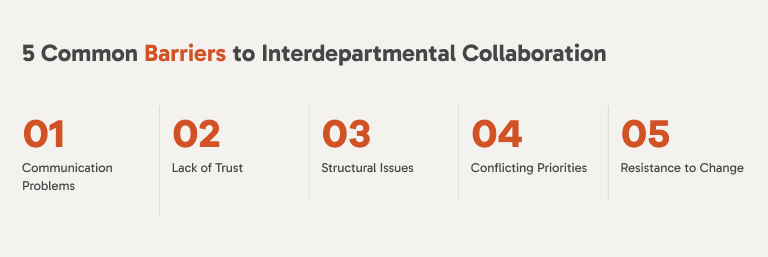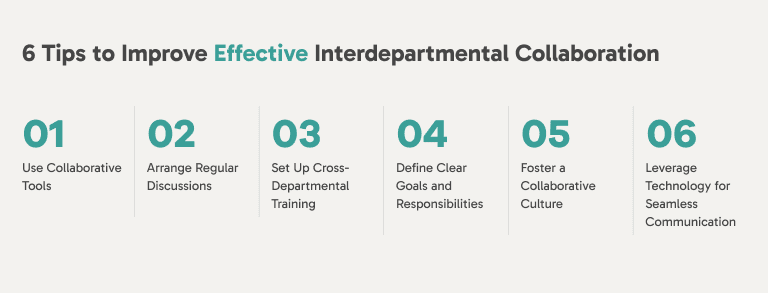project management · Jan 22, 2025
How to Improve Interdepartmental Collaboration

What is Interdepartmental Collaboration?
Interdepartmental collaboration refers to the seamless coordination and cooperation between different departments within an organization. It involves sharing resources, knowledge, and expertise to achieve a common goal.
Teams that practice effective interdepartmental collaboration often foster a dynamic and inclusive work environment. These interdepartmental teams are characterized by open communication, mutual respect, and a shared commitment to achieving organizational objectives.
5 Benefits of Successful Interdepartmental Collaboration

1. Enhancing Employee Engagement
When interdepartmental teams collaborate, they gain a broader understanding of the organization’s goals. This alignment fosters a sense of belonging and purpose. Employees feel valued when their contributions play a visible role in achieving larger objectives, which can significantly boost morale.
Furthermore, regular interdepartmental interactions create opportunities for employees to build relationships across teams, deepening their connection to the organization and enhancing overall workplace satisfaction.
2. Increased Innovation
Collaboration across departments brings diverse perspectives to the table. Different teams often approach problems from unique angles based on their expertise and experience. This diversity sparks creativity and leads to innovative solutions.
For instance, when marketing teams share customer insights with product developers, it can lead to designing features that better meet market demands. Additionally, interdepartmental brainstorming sessions often uncover creative opportunities that a single department might overlook.
3. Enhanced Professional Growth
Interdepartmental collaboration exposes employees to new skills, tools, and methodologies. For example, a finance professional collaborating with a design team may learn about visual storytelling and branding strategies, while the design team gains insights into budgeting and financial planning.
This cross-functional exposure not only broadens individual skill sets but also encourages employees to think beyond their departmental silos. Over time, such experiences foster a culture of continuous learning and professional growth, benefiting both individuals and the organization.
4. Streamlined Processes
Collaboration helps eliminate redundancy and inefficiencies that arise from siloed operations. When departments share their processes and resources, they can identify overlapping tasks and consolidate efforts.
For example, a marketing team working closely with a sales team can synchronize campaign schedules with product launches, ensuring cohesive messaging and avoiding duplicated efforts. This alignment not only saves time but also ensures that resources are allocated effectively, leading to smoother operations.
5. Better Customer Satisfaction
When departments communicate and collaborate effectively, the end-user benefits significantly. Seamless coordination between teams, such as sales and customer support, ensures that customer needs are met promptly and accurately.
For example, if a customer raises a concern, the support team can quickly collaborate with the product development team to provide a timely solution. This level of responsiveness enhances the customer experience, builds trust, and fosters loyalty. Moreover, when marketing and service teams work together, customers receive consistent messaging, further strengthening the brand’s reputation.
5 Common Barriers to Interdepartmental Collaboration

1. Communication Problems
Miscommunication or a lack of communication can create misunderstandings and hinder team collaboration. Different departments often use unique jargon or operate on distinct schedules, making alignment challenging. For instance, a technical team might use industry-specific terminology unfamiliar to a marketing team, leading to confusion during project discussions. This disconnect can slow down progress and result in errors.
2. Lack of Trust
Trust issues can arise when departments work in silos or when there is a history of competition rather than cooperation. A lack of trust can lead to resistance and hesitancy in sharing information. For example, a sales team may withhold customer feedback from the product development team due to fears of losing control over strategic decisions. Such behavior hinders the flow of valuable insights and reduces overall efficiency.
3. Structural Issues
Organizational structures that emphasize hierarchy over collaboration can impede interdepartmental initiatives. Rigid departmental boundaries often restrict the free flow of ideas and resources. For instance, a company with strict approval processes might delay decision-making, preventing teams from responding quickly to market changes or customer demands.
4. Conflicting Priorities
Each department may have its own objectives, which may not always align with the organization’s overarching goals. These conflicting priorities can create friction and reduce the effectiveness of collaborative efforts. For example, while the marketing team focuses on launching a campaign quickly, the product team may prioritize refining features, causing delays and frustration.
5. Resistance to Change
Employees may resist interdepartmental collaboration due to a reluctance to embrace new concepts or concerns about increased workload. To address this, it is crucial to demonstrate the tangible benefits of collaboration. For example, interdepartmental team members might worry that collaborative projects will disrupt their regular tasks. Highlighting how collaboration aligns with personal growth, enhances efficiency, and supports organizational success can help overcome resistance and build confidence in the process. Clear communication and emphasizing mutual benefits are key to fostering acceptance and engagement.
6 Tips to Improve Effective Interdepartmental Collaboration

1. Use Collaborative Tools
Adopting tools like Quire can bridge gaps between departments. Quire’s task management system allows teams to assign tasks clearly, share progress updates, and manage deadlines efficiently.
For example, during a product launch, marketing can assign content creation tasks to design while keeping sales informed of the campaign’s progress in real time. This centralized platform ensures everyone is aligned and reduces the risk of overlooked responsibilities.
2. Arrange Regular Discussions
Scheduling regular cross-departmental meetings promotes open dialogue and ensures everyone stays on the same page.
For instance, a weekly meeting between the IT and HR teams can help streamline the integration of new software tools with employee onboarding processes. These discussions not only identify bottlenecks but also foster a culture of continuous improvement by encouraging feedback and brainstorming.
3. Set Up Cross-Departmental Training
Training sessions that involve multiple departments encourage employees to understand each other’s roles and responsibilities. For example, a workshop where the sales team learns about the production process can help them better communicate product value to customers.
Similarly, customer support staff gaining insights from R&D teams can provide more informed solutions to client queries. This mutual understanding builds empathy and facilitates smoother collaboration.
4. Define Clear Goals and Responsibilities
Clarifying objectives and roles ensures that everyone knows their contribution to interdepartmental projects. For example, during a corporate rebranding effort, defining tasks such as logo design for the creative team, market analysis for the strategy team, and public relations management for the communications team can streamline execution.
Establishing measurable goals further helps in tracking progress and celebrating milestones.
5. Foster a Collaborative Culture
Leadership plays a critical role in fostering a collaborative culture. By actively promoting and modeling collaborative behaviors, leaders set the tone for teamwork.
Recognizing and rewarding successful interdepartmental initiatives can motivate employees to prioritize collaboration. For example, celebrating a project where marketing and IT teams worked together to launch a new app demonstrates the value of cross-functional efforts.
6. Leverage Technology for Seamless Communication
Investing in robust communication platforms ensures that teams can connect effortlessly, regardless of location. Tools like Slack or Microsoft Teams allow instant messaging, file sharing, and video conferencing.
For example, a global company with teams across different time zones can use these tools to maintain real-time communication and share updates, ensuring no department feels isolated or out of the loop.
Quire: The Ideal Tool for Interdepartmental Collaboration
Quire offers a comprehensive platform designed to streamline interdepartmental collaboration. Here’s how it helps:
- Task Management: Assign tasks across departments with clarity. For instance, marketing teams can assign content requirements directly to the design team, ensuring no details are overlooked.
- Real-Time Updates: Quire’s real-time sync feature keeps all stakeholders informed about project progress, reducing the chances of miscommunication.
- Shared Workspaces: Teams from different departments can collaborate in a unified workspace, fostering transparency and accountability.
- Customizable Subtasks: Break down complex projects into manageable subtasks. For example, a product launch can be divided into design, production, and marketing phases, each assigned to respective departments.
- Seamless Integration: Quire integrates with tools like Google Calendar and Slack, ensuring smooth communication and scheduling.
Real-Life Application: A Case Study
Consider a tech company planning a product launch. Using Quire, the product development, marketing, and sales teams collaborate effectively. The marketing team outlines campaign requirements, the product team updates development timelines, and the sales team shares customer feedback. With Quire’s unified platform, all teams stay aligned, ensuring a successful launch.
Interdepartmental collaboration is crucial for modern organizations to thrive. By addressing barriers to collaboration and leveraging tools like Quire, teams can unlock their full potential and achieve outstanding results.

